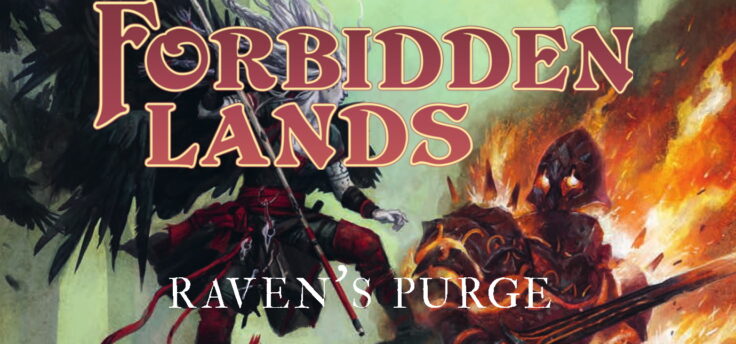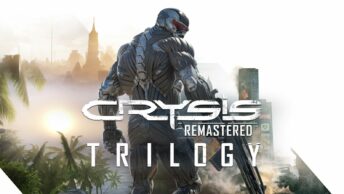How can you go off the rails when there are no tracks?
Free League
Genre: Tabletop RPG
Developer: Free League Publishing
Publisher: Free League Publishing
Release date: 6 Dec, 2018


When Forbidden Lands was released the Raven’s Purge campaign was released alongside it. Since then another campaign, The Bitter Reach has also been released, and a third one called Bloodmarch got kickstarted earlier this year, and is expected to be released in August 2022. Raven’s Purge builds upon the plot threads introduced in the GM section of Forbidden Lands and ties in directly with the history of the Ravenlands.
As this is a review for a campaign, it will contain spoilers. If you’re not considering running this as a GM then stop reading now, or you’ll just ruin the fun for yourself and the rest of your group.
Raven’s Purge is an open-ended open world sandbox campaign that really commits to its “sandbox” component, lacking a strong overarching story and pre-set outcomes like most linear campaigns do, and instead give the players a lot of freedom in what side they take (if any), who they make friends with and where they go.
This review is based on the Swedish edition of Raven’s Purge, and a few terms and names might have been mistranslated in the review, but the actual campaign should be the same.
The Setup
The crown called Steningast is a powerful artifact that was crafted a long time ago to house what, according to legend, were the rubies of the first six elves who fell to the Ravenlands, the elves who helped shape the land and make it into a beautiful and hospitable place to live. These rubies still house the living souls of these elves, though some have been separated from the crown, and have found themselves in other artifacts scattered around the Ravenland.

The crown, even without all the gems, is still a powerful artifact that can be used for good or evil, though were all the missing gems to be put into it its power would grow considerably. Several people, or beings, are looking for the crown and its gems, including Zytera (the being who’s an amalgamation of Zygofer and his daughter, and who’s responsible for unleashing the daemons on the land), Kartorda, leader of the Rust Church, Princess Arvia of Crombe who want to expel Zytera from the former homeland of her clan, or even better kill him/her, as well as several others. Not everyone has as grand plans for the crown, and some are nobler than others, but everyone has a reason for wanting it and are willing to go quite far to get it.
The Structure of the Campaign
Raven’s Purge is an open-ended campaign without any set path through it, or even a big “push” for the players to go out adventuring. With the exception of the final location, all the locations can be done in any order the players & GM wants, and not all of them are necessary to go through. In fact none of them are strictly necessary for the campaign, though the final location, the old dwarven stronghold of Vond, where Zytera dwells, might is tough to skip entirely. Though as long as the players encounter Steningast, know about the rubies and figure out what they want to do with the crown the campaign can go in any direction. It would be entirely possible for the players to find the crown and then decide that it’s too powerful to remain on land, so they just go out to sea and dump it, and then all that would be left would be dealing with anyone who’s angry about what they did, and that would be a valid (if somewhat anti-climatic) resolution to the campaign.

There are plenty of legends & clues that are meant to guide the players to the right locations, and give them more information about the different artifacts and powerful individuals. These are really the core of what’s likely to drive the players forward, and clue them in on anything that’s not obvious, though each location in the campaign also comes with a few suggestions for how to get the players there (without forcing their hand).
Each location in the book, as well as the ones in the GM’s section of the core rules, are in some ways related to the campaign, though not all of them have a strong connection to it. The ogre party pit that is Ravenhole for an example feels tenuously connected to the campaign, and is more a fun place to visit than a vital location.
Due to the campaigns very loose structure it’s easy to move things around, and while there are suggested locations for the artifacts and the major individuals, it’s perfectly possible to move them somewhere else. Not everyone or everything might necessarily make sense at every single location, but there are multiple places where everything can be. It’s also very easy to throw in other locations and have the players go on unrelated adventures if they want to, or just move something important to the campaign there, either ones you’ve come up with yourself, or any other pre-made location. All of this also means that the length of the campaign will vary significantly between groups. It’s unlikely that it will take less than 10 sessions to go through, but there’s no real limit to how long it will take. One group might be done with it in two to three months of regular play, another might spend two years and still not be done with it.
The Role of the Players
It’s unlikely that the player characters will start out being aware of the crown and its powers, or even most of the people who are after it. They might have heard about Zytera from the rust brothers who worship him, particularly if they’ve been adventuring for a while, but not know the true nature of that being.
The players can take any role they want in the campaign, side with anyone or no-one, and the campaign will still work. They just need to be invested in getting hold of Steningast and the rubies. Who they side with can have a big impact on the nature of the campaign though. Siding with Zytera (or one of its two halves) will lead to a completely different outcome than siding with the orc empress Soria. Who they side with, and what they’ve done along the way will matter the most in Vond, at the end of the campaign, where it’s likely that the forces of Zytera and the Rust Brothers will clash with whoever the players have helped, though if the players have instead sided with the Rust Brothers then there might not even be a clash there at all.
The Locations
There are nine different locations in the book (back of the book says 8, but there are in fact 9), each one comes with its own legend and conflicts. They’re structured the same way as the locations in the base game, with a way to get there, a map with important places marked on it, followed by a description of these places, then a description of any important people in that location and finally some events that might happen there. There’s no linear set of events that the players need to go through in any of these locations, though some are by their very nature more linear than others (it’s hard to make a dungeon entirely non-linear after all).

A lack of variety is not something you can complain about with these locations, from the seaside village of Pelagia where druids live, and where the only way they can find out certain things is to figure out how a (simple) writing system works for a foreign language, to the old dwarf city of Stonegarden, where the players might end up venturing down to see the ancient dwarves (dwelvers) who live underneath it, and possibly free a dragon (or slay it.. or just ignore it) to Amber’s peak where Zertorme, son of Zygofer is experimenting on creatures, imbuing them with fire to use against his father, to the above mentioned ogre party pit of Ravenhole.
Many of the locations do a pretty good job at also expanding the world a bit, and showing the different kinds of people and conflicts that are common here, and the introductions feel pretty organic. And these conflicts are ongoing, the players might (conveniently) step in when something is actually happening, but it feels like were they not there things will still happen, and they are neither the instigators of the conflicts nor the ones who will ultimately be able to solve them, even if they might be able to put a lid on things for now, depending on their actions.
All of the locations, even Vond, can also be used on their own as well. Even if the idea of finding Steningast and deciding its faith does not appeal to you, all of the locations are useful as just general places the players might come across during their adventures, and most conflicts that take place in these locations are not tied directly to Steningast or the other gems.
A Few Things to Watch Out for
With a campaign as open as this there’s not a whole lot that can stall it. No matter who lives or dies, who becomes friend or enemy the campaign can still continue unhindered. But that does not mean that running it is entirely without potential pitfalls.

As a GM you’ve got a potentially tough balancing act running this campaign. You need to make it progress, somehow, and the book does not really give a lot of guidance for how to do this, and at the same time make sure that the players don’t feel like you’re railroading them. This can be easier said than done at times. Some of the opposition can also be really tough and so even if the it says that a place has a certain number of enemies you’ll have to tweak that based on your party. Make sure to also foreshadow anything that can be a problem, like the slime creatures in the Stone Garden, or the mine cart in The Stoneloom Mines. Vond can also turn deadly really fast if the players are not prepared. There are also several places where it’s very easy for the players to miss something vital, like the importance of the cloak clasp that’s recommended to be found in Eye of the Rose (not that a GM can’t just move the artifact if the players did not notice it when they’re there)
Art, Layout and Quality
Like the books in the core box Raven’s Purge tries to capture the feel of 80’s RPGs with its art. Everything in the book is still black & white, and there’s still a mix of art from the 80’s, and art that looks like it might well have been but has been purpose made for the this game. It still feels coherent and the art is good and it fits the style and tone of the game, although it might not have the “wow” factor of some of the full colour art in other modern RPGs.

Sadly the maps suffer from the same issue as the ones in the GM’s section of the core set, where they are spread out over two pages, and a lot of important locations are near the middle. That’s not a problem on a PDF, but in a physical book it does mean that there are places that are somewhat obscured.
The book is laid out in a logical way, with an introduction to the campaign and the backstory at the start, followed by information about the artifacts and the major characters in the campaign and then the major locations in no particular order (with Vond being at the end) as well as information about what might happen after the campaign, depending on the actions of the players. Finally the legends regarding the different locations, artifacts and characters are at the back of the book, in a printer/photocopy friendly format, that can serve as handouts during sessions.
As you would expect from Free League the book feels sturdy and like it can handle a lot of use at the table. It’s a hardcover book though this time the cover is not faux leather, unlike the core books. It is the same format as the core books though, and would sit well on a shelf next to them.
Closing Thoughts
Raven’s Purge really commits to the whole “open ended” approach of Forbidden Lands, and that might throw some people off. There’s hardly any structure here, all you get are a few pieces and then you need to figure out how you think they should go together. That approach has both its advantages and disadvantages. A big disadvantage is that it does not offer as much guidance for the GM, who has to put in a lot of work themselves to figure out how to get the players involved and how to progress things. On the other hand it also makes for a campaign where the players are truly involved and help shape it, and if the players do something crazy like kill a plot-central NPC or just refuse to do something vital, you don’t have to bend over backwards and try to “fix” it in order to progress the campaign.
Raven’s Purge is a good campaign, and a good introduction to the style of gameplay found in Forbidden lands, even if it requires a bit of extra prepwork from the GM. It’s not perfect, the story for an example is just fine (the outcome can end up being pretty memorable though), and finding pieces of an artifact scattered across the land is not the most original setup for an open ended campaign, but overall it is a campaign that is fun to play and it’s one of the few where the players truly have a say over the outcome, they don’t just either win or lose, their actions really do have a large influence on the story and the direction the campaign takes.










